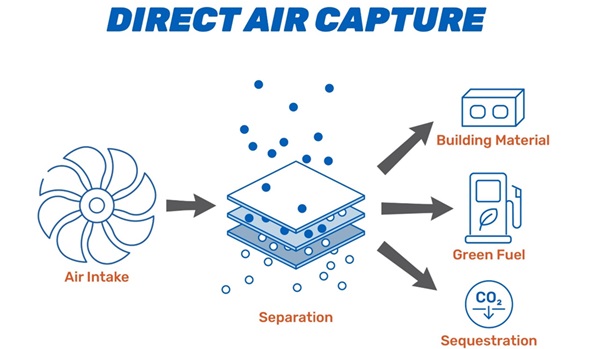- The world’s largest Direct Air Capture and Storage (DAC+S) plant, named Mammoth, has started operation in Iceland.

What is DAC+S Technology?
- The Mammoth DAC+S plant, located in Hellisheidi, Iceland, represents a significant advancement in carbon dioxide removal (CDR) technologies.
- Operated by Climeworks, this facility commenced operations in May 2024 and is currently the world's largest of its kind.
- It underscores the growing emphasis on innovative solutions to mitigate climate change by removing CO₂ directly from the atmosphere.
Understanding DAC+S Technology
- Direct Air Capture and Storage (DAC+S) involves:
- CO₂ Extraction: Using large fans, ambient air is drawn into the system. The air passes through filters containing a chemical solution that binds with CO₂ molecules.
- CO₂ Release: The filters are heated, releasing the captured CO₂ as a concentrated gas.
- CO₂ Storage: The concentrated CO₂ is then injected into deep geological formations, where it mineralizes and is permanently stored underground.
- This process not only reduces atmospheric CO₂ levels but also offers a scalable method to achieve negative emissions, which are essential for meeting global climate targets.
Role of Carbon Dioxide Removal (CDR)
- CDR encompasses various strategies aimed at removing CO₂ from the atmosphere and securely storing it.
- The Intergovernmental Panel on Climate Change (IPCC) identifies CDR as a critical component in achieving net-zero greenhouse gas emissions.
- Other CDR methods include:
- Afforestation and Reforestation: Planting trees to absorb CO₂.
- Soil Carbon Sequestration: Enhancing soil management to increase carbon storage.
- Ocean-based CDR: Techniques like ocean fertilization to boost marine carbon uptake.
- Bioenergy with Carbon Capture and Storage (BECCS): Growing biomass for energy and capturing the resulting CO₂ emissions.
- While these methods are valuable, DAC+S provides a direct approach to removing CO₂ from the air, offering flexibility in deployment and the potential for significant impact.
Operational Scale and Impact
- The Mammoth plant is designed to capture up to 36,000 tons of CO₂ annually.
- This capacity is approximately ten times greater than its predecessor, the Orca plant, also in Iceland.
- The captured CO₂ is permanently stored underground through a partnership with Carbfix, utilizing Iceland's geothermal resources for mineralization.
- Climeworks aims to scale up its operations to achieve megaton-scale carbon removal by 2030 and gigaton-scale by 2050, aligning with global efforts to combat climate change.
Challenges and Considerations
- Despite its potential, DAC+S faces several challenges:
- High Costs: Current estimates place the cost of capturing CO₂ at over $1,000 per ton, primarily due to the energy-intensive nature of the process and the scale of current facilities.
- Energy Requirements: DAC+S systems require substantial amounts of energy, necessitating a reliable and renewable energy supply to ensure net-negative emissions.
- Infrastructure Needs: The establishment of DAC+S facilities requires significant infrastructure, including access to suitable geological storage sites and transportation networks for CO₂.
- Policy and Investment: Sustained government support and private investment are crucial to drive innovation, reduce costs, and expand deployment.
Global Perspective
- While Iceland has become a leader in DAC+S technology, other countries are exploring similar initiatives.
- For instance, the United States has initiated DAC projects, such as the facility in Tracy, California, which employs limestone to capture CO₂ and store it in concrete.
- These efforts highlight the global recognition of DAC+S as a viable solution for carbon removal.
Relevance to India
- For India, DAC+S presents both opportunities and challenges:
Opportunities:
- Climate Leadership: Investing in DAC+S can position India as a leader in innovative climate solutions.
- Technology Development: Promoting research and development in DAC+S technologies can spur domestic innovation and industry growth.
- International Collaboration: Engaging in global DAC+S initiatives can enhance India's participation in international climate agreements and partnerships.
Challenges:
- High Costs: The current expense of DAC+S may be prohibitive, especially for a developing economy.
- Energy Demand: India's energy infrastructure may need significant upgrades to support the energy requirements of DAC+S systems.
- Policy Framework: Establishing supportive policies and incentives for DAC+S development is essential.
Addressing these challenges through strategic planning and investment can enable India to leverage DAC+S technology effectively.